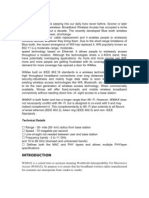Wimax: Broadband Wireless Access: CRM Software: Small Business Software
Wimax: Broadband Wireless Access: CRM Software: Small Business Software
Uploaded by
umarhidayatCopyright:
Available Formats
Wimax: Broadband Wireless Access: CRM Software: Small Business Software
Wimax: Broadband Wireless Access: CRM Software: Small Business Software
Uploaded by
umarhidayatOriginal Title
Copyright
Available Formats
Share this document
Did you find this document useful?
Is this content inappropriate?
Copyright:
Available Formats
Wimax: Broadband Wireless Access: CRM Software: Small Business Software
Wimax: Broadband Wireless Access: CRM Software: Small Business Software
Uploaded by
umarhidayatCopyright:
Available Formats
WiMAX: Broadband Wireless Access
Page 1 of 4
IT Developer News
CRM Software:
Small Business Software:
Accounting Software DepositNow A/R for QuickBooks Small Business Software
Small Business Personal Tech Events Jobs
GoldMine CRM Software CRM Software by Exact e-Synergy Sage MAS CRM Software Solutions
Partners IT MANAGEMENT Solutions Shop Login Register
NETWORKING
WEB DEVELOPMENT
HARDWARE & SYSTEMS
SOFTWARE DEVELOPMENT
IT NEWS
Developer.com CodeGuru | Gamelan | Jars | Wireless | Discussions
Architecture & Design Database Java Languages & Tools Microsoft & .NET Open Source Project Management Security Techniques Voice
IDC Brief: How Small Businesses Can Boost Worker Productivity with Wireless Technology. Learn how to help small businesses become more efficient & extend your reach in an increasingly competitive world.
WiMAX: Broadband Wireless Access
By Xiaole Song
WiMAX (Worldwide Interoperability for Microwave Access) is the IEEE 802.16 Web Services standards-based wireless Wireless/Mobile technology that provides MAN XML (Metropolitan Area Network) broadband connectivity. WiMAX is Technology Jobs an Air Interface for Fixed Broadband Wireless Access Developer.com Webcasts: Systems, also known as the IEEE The Impact of Coding WirelessMAN air interface. Standards and Code WiMAX-based systems can be Reviews used to transmit signals as far as Project Management 30 miles. So far, WiMAX can offer a solution to what is normally for the Developer called the "last-mile" problem by connecting individual homes' and Defining Your Own Software business offices' communications.
Development Methodology
Software Engineering with Microsoft Visual Studio Team System
Get a free copy of Software Engineering with Microsoft Visual Studio Team System to get a broad and thoughtful view on how to approach software engineering from a value-up paradigm.
more Webcasts...
Cable/DSL Broadband Access
Currently, there are cable and DSL broadband access services in the marketplace. But, their practical limitations in features and deployment have prevented them from reaching many potential broadband Internet customers. The wired broadband connection provided by cable and DSL is an all-consuming and
The Microsoft Platform - Driving Your Business Forward with ALM
Driving Your Business Forward with Application Lifecycle Management (ALM). Read this whitepaper to find out how you can get started with and the business benefits that you can achieve with an ALM strategy.
See the Winners!
Otellini's Vision: Augmented Reality, Personal Internet
http://www.developer.com/ws/proto/article.php/3412391
1/9/2008
WiMAX: Broadband Wireless Access
Page 2 of 4
Internet Security:
Time Warner Cable Business Class: Internet Service Provider
Application Security
Secure, Remote PC Access
expensive process. A large January 8, 2008 number of areas throughout the Yahoo's Mobile Mandate January 7, 2008 world currently are not able to 'I Pity Da Fool That Doesn't Take This Exit!' January 4, 2008 access broadband connectivity. Traditionally, DSL can only reach The Mobile Web, ChaCha Style January 4, 2008 about 18,000 feet (three miles) from the central office switch, and this limitation means that Developer.com Update many urban and suburban locations may not be served by DSL connectivity. The limitation of cable is that many older cable networks have not been equipped to offer a return channel, and converting and deploying these networks to support high-speed broadband can be expensive.
Internet Security Open a Business Account
Wireless Standards
Drawing on hundreds of experts in the telecommunications industry, the IEEE has established a collection of wireless standards that include IEEE 802.15, also known as Bluetooth, for the Personal Area Network (PAN); IEEE 802.11, also known as WiFi, for the Local Area Network (LAN); 802.16 for the Metropolitan Area Network (MAN), and IEEE 802.20 for the Wide Area Network (WAN). Unlike WiFi, WiMAX's range is typically measured in miles rather than feet. The main distinction of the difference between the two standards means that WiFi is focused on a local-area networking (LAN) technology and that WiMAX is a MAN technology. The 802.16d standard of extending 802.16 supports three physical layers (PHYs). The mandatory PHY mode is 256-point FFT Orthogonal Frequency Division Multiplexing (OFDM). The other two PHY modes are Single Carrier (SC) and 2048 Orthogonal Frequency Division Multiple Access (OFDMA) modes. By the way, the corresponding European standardthe ETSI HiperMAN standarddefines a single PHY mode identical to the 256 OFDM modes in the 802.16d standard.
Information Technology Services:
Healthcare Info Technology Consulting
Hands-On, Instructor-Led Computer / IT Training
Why WiMAX?
WiMAX covers a couple of different frequency ranges. Basically, the IEEE 802.16 standard addresses frequencies from 10GHz to 66GHz. The 802.16a specification, which is an extension of IEEE802.16, covers bands in the 2GHz-to-11GHz range. WiMAX has a range of up to 30 miles with a typical cell radius of 46 miles. WiMAX's channel sizes range from 1.5 to 20MHz as well, and offer a WiMAX-based network the flexibility to support a variety of data transmitting rates such as T1 (1.5Mbps) and higher data transmitting rates of up to 70Mbps on a single channel that can support thousands of users. This flexibility allows WiMAX to adapt to the available spectrum and channel widths in different countries or licensed to different service providers. WiMAX supports ATM, IPv4, IPv6, Ethernet, and VLAN services. So, it can provide a rich choice of service possibilities to voice and data network service providers. In addition, WiMAX provides an ideal wireless backhaul technology to connect 802.11 wireless LANs and commercial hotspots with the Internet.
Free Info-Tech Research
Find Av Products at TDC Online Sourcing
Be a Commerce Partner PDA Phones & Cases Promotional Items Web Design Memory Online Universities Corporate Awards
The WiMAX-based solution is set up and deployed like cellular systems using base stations that service a radius of several miles/kilometers. The most typical WiMAXbased architecture includes a base station mounted on a building and is responsible for communicating on a point to multi-point basis with subscriber stations located in business offices and homes. The customer premise equipment (CPE) will connect the base station to a customer as well; the signal of voice and data is then routed through standard Ethernet cable either directly to a single computer, or to an 802.11 hot spot or a wired Ethernet LAN.
http://www.developer.com/ws/proto/article.php/3412391
1/9/2008
WiMAX: Broadband Wireless Access
Page 3 of 4
Internet Security Complex Webhosting Cell Phones Business Lists Domain Registration Build a Server Rack Computer Deals Equipment Leasing
WiMAX-based solutions include many other advantages, such as robust security features, good QoS (Quality of Service), and mesh and smart antenna technology that will allow better utilization of the spectrum resources. Also, the WiMAX-based voice service can work on either traditional Time Division Multiplexed (TDM) voice or IP-based Voice, also known as Voice over IP (VoIP).
WiMAX Connectivity and Solutions
WiMAX allows equipment vendors to create many different types of IEEE802.16-based products, including various configurations of base stations and customer premise equipment (CPE). WiMAX also allows the services provider to deliver many types of wireless access services. The WiMAX can be used on a variety of wireless broadband connections and solutions:
z
"Last Mile" Broadband Access SolutionMetropolitan-Area Networks (MAN) connections to home and business office, especially in those areas that were not served by cable or DSL or in areas where the local telephone company may need a long time to deploy broadband service. The WiMAX-based wireless solution makes it possible for the service provider to scale-up or scale-down service levels in short times with the client request. Backhaul networks for cellular base stations, bypassing the Public Switched Telephone Network (PSTN); the cellular service providers can look to wireless backhaul as a more cost-effective alternative. The robust WiMAX technology makes it a nice choice for backhaul for enterprises such as hotspots as well as point-to-point backhaul solutions. Backhaul enterprise connections to the Internet for WiFi hotspots. It will allow users to connect to a wireless Internet service provider even when they roam outside their home or business office. A variety of new business services by wireless Internet service provider.
Who Are Working on WiMAX?
The WiMax Forum is a non-profit organization formed in 2001 by Nokia Corp. and Ensemble Communications Inc., etc. Right now, the WiMAX Forum has more than 110 members of equipment, semiconductor suppliers, and services providers such as Alcatel, AT&T, Fujitsu, Intel, Nortel, Motorola, SBC and Siemens, and so forth. The WiMax Forum aims to support wireless metropolitan-area networking products based on IEEE 802.16, like the Wi-Fi Alliance has done for wireless LANs and IEEE 802.11. The WiMAX Forum has most recently been working to promote the adoption of IEEE 802.16compliant equipment, certification, and interoperability testing. In 2003, Intel Corp. became a major supporter of the WiMax Forum. In order to bring interoperability into MAN, the WiMAX Forum is focusing its efforts on establishing a baseline protocol that allows equipment and devices from multiple vendors to interoperate and that also provides a choice to buy equipment and devices from different suppliers. Currently, there are no WiMax-certified products yet available in the market, but the race is already on. At the Intel Developer Forum in September 2004, Intel showed off its first samples of a WiMAX chipset that has been named Rosedale. Intel is planning to offer WiMax transmitters by 2005, and expects to ship WiMax devices for the home and office to take off by 2006. Also, Intel hopes that notebooks will begin to incorporate WiMAX technology during 2006, and by 2007, handsets for mobility will be available. Intel has already signed up Proxim and Alcatel to develop WiMAX base-station and CPE (Customer Premises Equipment) kits. Fujitsu Microelectronics America Inc. in early 2005 expects to introduce a new WiMAX-based single-chip solution for deployment in base stations and subscriber stations as well; the product integrates both PHY and MAC functionality. Siemens Information and Communication Mobile also plans to build complete WiMAX-based solutions for establishing fixed, broadband speed metropolitan area wireless radio networks.
http://www.developer.com/ws/proto/article.php/3412391
1/9/2008
WiMAX: Broadband Wireless Access
Page 4 of 4
About the Author
Xiaole Song is a professional designing, integrating and consulting Telecommunication, IP Telephony, Computer Telephony Integration, and Speech applications. Feel free to email any comments about this article to xiaole_song@yahoo.com.
Tools: Add www.developer.com to your favorites
Add www.developer.com to your browser search box IE 7 | Firefox 2.0 | Firefox 1.5.x Receive news via our XML/RSS feed
Protocols/Standards Archives
Article: Service Creation Environments Offer Familiar Tools for Creating Converged Applications Article: Migrating from Oracle--When SQL Server 2005 Makes Sense Whitepaper: Integrate SharePoint into WebSphere Portal eBook: Tips for Selecting Software Vendors. Sponsored by Oracle. Tutorial: Create WebSphere Portal Applications using the Visual Studio IDE
Search:
Jupitermedia Corporation has two divisions: Jupiterimages and JupiterOnlineMedia Jupitermedia Corporate Info Copyright 2008 Jupitermedia Corporation All Rights Reserved. Legal Notices, Licensing, Reprints, & Permissions, Privacy Policy. Advertise | Newsletters | Tech Jobs | Shopping | E-mail Offers
http://www.developer.com/ws/proto/article.php/3412391
1/9/2008
You might also like
- ENVI Met TutorialDocument45 pagesENVI Met TutorialOliveiro Alvarado75% (8)
- Dark Void (Official Prima Guide)Document161 pagesDark Void (Official Prima Guide)mikel4carbajoNo ratings yet
- Your Own Marimba PDFDocument17 pagesYour Own Marimba PDFIgorNo ratings yet
- Mill Testing Optimisation and TargetingDocument134 pagesMill Testing Optimisation and TargetingArtemMirra90% (10)
- Esquema SamsungDocument60 pagesEsquema SamsungCleumo BarrosNo ratings yet
- Alexandria University Faculty of Engineering Electrical Comm. Department Fourth YearDocument24 pagesAlexandria University Faculty of Engineering Electrical Comm. Department Fourth YearyacineNo ratings yet
- WifiDocument13 pagesWifiMitesh ChaudharyNo ratings yet
- Wi-Max - A Evolving 4G TechnologyDocument18 pagesWi-Max - A Evolving 4G TechnologyMadhusmita PandaNo ratings yet
- Wimax: Wimax (Worldwide Interoperability For Microwave Access)Document5 pagesWimax: Wimax (Worldwide Interoperability For Microwave Access)hamidNo ratings yet
- Wimax Benefits Applications & Solutions: Key Challenges: Key Challenges: Key Challenges: Key ChallengesDocument7 pagesWimax Benefits Applications & Solutions: Key Challenges: Key Challenges: Key Challenges: Key ChallengesJohn C. YoungNo ratings yet
- Wimax TechDocument1 pageWimax TechNamitha P ShettyNo ratings yet
- Wi-Max Communication System - by Salman HasanDocument44 pagesWi-Max Communication System - by Salman Hasanapi-19781188100% (1)
- Fixed and Mobile Wimax: Anuj Sakhardande, Valerie Monteiro, St. Xaviers Technical Institute, Mahim. Mpproex 2010Document6 pagesFixed and Mobile Wimax: Anuj Sakhardande, Valerie Monteiro, St. Xaviers Technical Institute, Mahim. Mpproex 2010Rajat DoshiNo ratings yet
- WimaxDocument13 pagesWimaxAmit MahawarNo ratings yet
- WiMAX EssentialsDocument100 pagesWiMAX EssentialsMd. Chhabibur Rahman100% (2)
- WIMAX - Research PaperDocument26 pagesWIMAX - Research PaperCyprene Fonnor PagueraoNo ratings yet
- Computer Networks and Communications2Document10 pagesComputer Networks and Communications2NandeshProNo ratings yet
- Answer: Gigabit EthernetDocument9 pagesAnswer: Gigabit EthernetRaine LopezNo ratings yet
- Wimax: Wimax (Worldwide Interoperability For Microwave Access) Is A Family of Wireless Communication StandardsDocument8 pagesWimax: Wimax (Worldwide Interoperability For Microwave Access) Is A Family of Wireless Communication Standardsfirstsight123No ratings yet
- Wimax: Worldwide Interoperability For Microwave AccessDocument20 pagesWimax: Worldwide Interoperability For Microwave Accessangeloflove15No ratings yet
- Wimax Versus Wi-Fi: A Seminar ReportDocument34 pagesWimax Versus Wi-Fi: A Seminar ReportTiju George VarugheseNo ratings yet
- Mis 7Document1 pageMis 7api-3761679No ratings yet
- WI MAX OverviewDocument22 pagesWI MAX OverviewnarayanbscribidNo ratings yet
- Wimax Worldwide Interoperability For Microwave AccessDocument9 pagesWimax Worldwide Interoperability For Microwave AccessamoghNo ratings yet
- Wimax: The Emerging Technology in Wireless CommunicationDocument5 pagesWimax: The Emerging Technology in Wireless CommunicationSahu BhimaNo ratings yet
- Scope in WiFiDocument5 pagesScope in WiFiSalman Khan0% (1)
- WimaxDocument16 pagesWimaxMohammed Fazle Sobhan ChowdhuryNo ratings yet
- BA-560 PaperDocument11 pagesBA-560 PaperSrinivas Pramod KNo ratings yet
- Wimax: Wi Max Navigation SearchDocument28 pagesWimax: Wi Max Navigation SearchMangesh GaykwadNo ratings yet
- Uttam Devi Mohan Lal College of Engineering Submitted By: Gaurav Sharma (08EUDEC030)Document17 pagesUttam Devi Mohan Lal College of Engineering Submitted By: Gaurav Sharma (08EUDEC030)Ankit SinghNo ratings yet
- Wireless Fidelity: Guided By: Hardik Kothari Submitted By: Yesha K. TrivediDocument33 pagesWireless Fidelity: Guided By: Hardik Kothari Submitted By: Yesha K. Trivedithisissanjay100% (1)
- Chapter 3 - Wlan Technologies: RTO-TR-IST-035 3 - 1Document20 pagesChapter 3 - Wlan Technologies: RTO-TR-IST-035 3 - 1Yogesh BhatiNo ratings yet
- Wi-Max & Wi-MAXDocument31 pagesWi-Max & Wi-MAXkumarswamykcNo ratings yet
- Wimax ReportDocument21 pagesWimax Reportmadhanmaddy777No ratings yet
- CBCN4103 Answer2Document15 pagesCBCN4103 Answer2Ryan JeeNo ratings yet
- History of WiMAX Auto Saved)Document15 pagesHistory of WiMAX Auto Saved)Francis AmaningNo ratings yet
- Wi PRNTDocument12 pagesWi PRNTHassan AtiqueNo ratings yet
- Emerging Broadband Wireless Technologies: WIFI and WIMAXDocument8 pagesEmerging Broadband Wireless Technologies: WIFI and WIMAXCS & ITNo ratings yet
- Wimax Quick GuideDocument16 pagesWimax Quick GuideramyaNo ratings yet
- Wi-Fi Technolog yDocument33 pagesWi-Fi Technolog yVinayaka KaranthNo ratings yet
- 2007 9.content.07653Document3 pages2007 9.content.07653Roshdy AbdelRassoulNo ratings yet
- What Are The Differences and Similarities Between Wi-Fi and Wimax?Document3 pagesWhat Are The Differences and Similarities Between Wi-Fi and Wimax?Salman KhanNo ratings yet
- TarunDocument2 pagesTarunInderjit SinghNo ratings yet
- Multimedia For The Enterprise WLANDocument10 pagesMultimedia For The Enterprise WLANEsme VosNo ratings yet
- Wimax: Wimax, Meaning Worldwide Interoperability For MicrowaveDocument13 pagesWimax: Wimax, Meaning Worldwide Interoperability For MicrowavegeorgeholdridgeNo ratings yet
- Chapter 5Document9 pagesChapter 5asmeabeba12No ratings yet
- Wimax AbstractDocument6 pagesWimax AbstractMaqsood UldeNo ratings yet
- 2 2. History of Wimax and Wi-Fi 5 3. The Need For Wimax 7 4. Technology Behind Wimax 14 5. Applications 23 6. Conclusion 24 7. References 25Document25 pages2 2. History of Wimax and Wi-Fi 5 3. The Need For Wimax 7 4. Technology Behind Wimax 14 5. Applications 23 6. Conclusion 24 7. References 25derviiiNo ratings yet
- Applications of Wireless Technologies in Mobile Computing and CommerceDocument5 pagesApplications of Wireless Technologies in Mobile Computing and CommerceJazz KheraNo ratings yet
- Wifi Offload ThesisDocument5 pagesWifi Offload Thesisjenniferlordmanchester100% (2)
- Wireless Fidelity: Technology and ApplicationsDocument22 pagesWireless Fidelity: Technology and ApplicationsPurboday GhoshNo ratings yet
- Wifi. What Is It?: NCR Corporation At&T Lucent Agere Systems NieuwegeinDocument17 pagesWifi. What Is It?: NCR Corporation At&T Lucent Agere Systems NieuwegeinYogesh JainNo ratings yet
- Wi MaxDocument42 pagesWi MaxShabeer AliNo ratings yet
- Wimax: Submitted To:-Ms. Pooja Dhiman Submitted By: - Priyanka Verma Ranjana RaniDocument13 pagesWimax: Submitted To:-Ms. Pooja Dhiman Submitted By: - Priyanka Verma Ranjana Ranipinks_vNo ratings yet
- Cornell Data Networking: Wired vs. Wireless?: Prepared by R. David VernonDocument8 pagesCornell Data Networking: Wired vs. Wireless?: Prepared by R. David VernonNour HrsNo ratings yet
- Wimax Is Defined As Worldwide Interoperability For Microwave Access by The Wimax Forum, Formed in June 2001 To Promote Conformance andDocument13 pagesWimax Is Defined As Worldwide Interoperability For Microwave Access by The Wimax Forum, Formed in June 2001 To Promote Conformance andSoorej KamalNo ratings yet
- Wimax: Wimax (Worldwide Interoperability For Microwave Access) Is A Family of WirelessDocument21 pagesWimax: Wimax (Worldwide Interoperability For Microwave Access) Is A Family of WirelessRadh KamalNo ratings yet
- Wimax: Wimax (Worldwide Interoperability For Microwave Access) Is ADocument12 pagesWimax: Wimax (Worldwide Interoperability For Microwave Access) Is AManoj AngamuthuNo ratings yet
- Wimax: Opportunity or Hype?: AuthorsDocument37 pagesWimax: Opportunity or Hype?: AuthorsSteveihNo ratings yet
- Router: Device Networks Wans ISP's GatewaysDocument14 pagesRouter: Device Networks Wans ISP's GatewaysMay Responte GayNo ratings yet
- Terminology: Wimax (Worldwide Interoperability For Microwave Access) Is ADocument15 pagesTerminology: Wimax (Worldwide Interoperability For Microwave Access) Is ADivyendu DasNo ratings yet
- Wireless Fidelity: Technology and ApplicationsDocument22 pagesWireless Fidelity: Technology and ApplicationsPurboday GhoshNo ratings yet
- Enviromental Considerations of Wireless Tools: Conducting A Site SurveyDocument6 pagesEnviromental Considerations of Wireless Tools: Conducting A Site SurveyOle ArrietaNo ratings yet
- Case Materials Tanzania 09 07Document19 pagesCase Materials Tanzania 09 07umarhidayatNo ratings yet
- 5c. 5G - Role of Fiber in Bangladesh by Dr. Darryll SinnappaDocument11 pages5c. 5G - Role of Fiber in Bangladesh by Dr. Darryll SinnappaumarhidayatNo ratings yet
- Ilham Habibie-Wantiknas-Audiensi Menteri BappenasDocument21 pagesIlham Habibie-Wantiknas-Audiensi Menteri BappenasumarhidayatNo ratings yet
- Link Net Company Presentation - Investor UpdateDocument47 pagesLink Net Company Presentation - Investor UpdateumarhidayatNo ratings yet
- FTTX Whitepaper September 2018Document27 pagesFTTX Whitepaper September 2018umarhidayatNo ratings yet
- Qos Spie03.PsDocument14 pagesQos Spie03.PsumarhidayatNo ratings yet
- Fluid Power System ENT367 Session 2020/2021 Semester 1Document6 pagesFluid Power System ENT367 Session 2020/2021 Semester 1norNo ratings yet
- Meter L&TDocument12 pagesMeter L&TnenusakNo ratings yet
- Chap 3.7 Seagrass EcosystemDocument96 pagesChap 3.7 Seagrass Ecosystemsuganya rameshNo ratings yet
- Your-V12 Vantage RoadsterDocument16 pagesYour-V12 Vantage RoadsteraryankachhadiaNo ratings yet
- Impact of Drug Addiction On Mental HealthDocument4 pagesImpact of Drug Addiction On Mental HealthNemat Kaurrajput10No ratings yet
- 10 Mechanical Equipment, Attachment PDFDocument8 pages10 Mechanical Equipment, Attachment PDFPeter BrickNo ratings yet
- Community Nutrition Position Paper - Should Foods Include A Mandatory Gmo LabelDocument3 pagesCommunity Nutrition Position Paper - Should Foods Include A Mandatory Gmo Labelapi-347957158No ratings yet
- 5 - Pair R. V.Document24 pages5 - Pair R. V.abd syNo ratings yet
- Đề tiếng Anh cấp 3Document5 pagesĐề tiếng Anh cấp 3dinhthien1016No ratings yet
- The Celebration of The EucharistDocument71 pagesThe Celebration of The EucharistShirly BenedictosNo ratings yet
- Immunization StatusDocument21 pagesImmunization StatusAubery RongNo ratings yet
- Case Study On Organic Versus Conventional Cotton in Karimnagar, Andhira Pradesh, IndiaDocument16 pagesCase Study On Organic Versus Conventional Cotton in Karimnagar, Andhira Pradesh, IndiaNainar ReddyNo ratings yet
- Primary Five - Set 20Document5 pagesPrimary Five - Set 20Monydit santinoNo ratings yet
- Non Peza ClientsDocument15 pagesNon Peza ClientsDioscoro J. Jebulan100% (1)
- Leakage Detection Using Fiber Optics Distributed Temperature MonitoringDocument8 pagesLeakage Detection Using Fiber Optics Distributed Temperature MonitoringeochiufpicNo ratings yet
- Theory of Karma: Prepared By: Milind GadhaviDocument15 pagesTheory of Karma: Prepared By: Milind GadhaviMilind GadhaviNo ratings yet
- Analytical Chem 3Document9 pagesAnalytical Chem 3bobby la fleurNo ratings yet
- Construction - 5 Shear Wall ...Document35 pagesConstruction - 5 Shear Wall ...gaurav chaudhariNo ratings yet
- Intake Runner Development For The 32v Porsche® 928: 928 Motorsports High-Flow IntakeDocument14 pagesIntake Runner Development For The 32v Porsche® 928: 928 Motorsports High-Flow IntakeITLHAPNNo ratings yet
- Srisailam HPSDocument4 pagesSrisailam HPSN. Sasidhar100% (1)
- Boq 608553Document15 pagesBoq 608553sahil kotwalNo ratings yet
- Vibrating Wire Load CellDocument4 pagesVibrating Wire Load Cells pradhanNo ratings yet
- Imperium 2Document68 pagesImperium 2Andrew Binks45% (11)
- Experimental Characterization of Mobile Iot Application LatencyDocument13 pagesExperimental Characterization of Mobile Iot Application LatencyakttripathiNo ratings yet






























































































